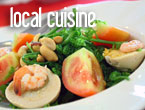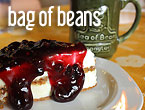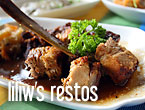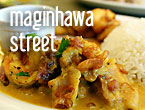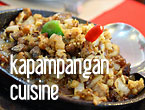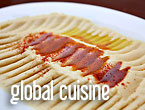Food Tripping in Pampanga
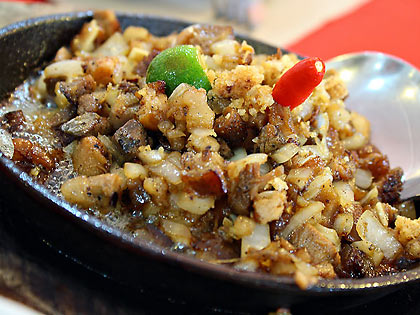
The pork or chicken adobo I have known growing up was of the "white" variety, stewed in vinegar with garlic and small bits of pork fat all fried to a crisp. It was therefore some sort of a culture shock for me when I encountered the variety of adobo that was made with soy sauce. All the while I thought the "white" adobo was native to my region of Southern Tagalog. It was only years later that I learned that the "white adobo" was a Kapampangan version – although the Visayans have a similar take on what many foreigners consider as the quintessential Filipino dish.
Years later I would marry a Kapampangan (who was born and raised in Metro Manila) and get my passion for food ignited even more. Nina and I are not only travel freaks. We are also adventurous when it comes to food. But even after having tasted a wide variety of dishes from all over the globe we keep coming back to our roots and for Nina it was returning to her native Pampanga – regarded as the culinary center of the Philippines and home to many of its greatest chefs.
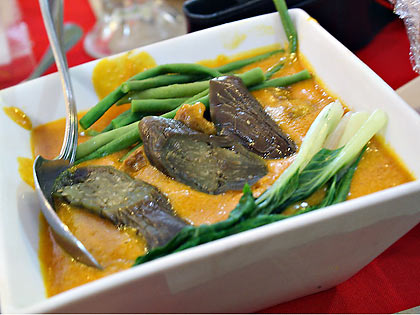
Kare-kare is said to have originated from Pampanga (although it may also have come from pre-Hispanic Muslim settlers in Manila).
On a Valentine's Day we decided – along with several friends – to go on a food trip to Angeles City in Pampanga, something we have been thinking about for a long time previously but somehow never found the time to do. There is a dizzying array of dining places that serve excellent traditional Kapampangan cuisine in this city alone – from hole-in-the-wall types to fine dining destinations. To better cater to everyone in the group we looked for something in between those two extremes and ended up having lunch at Binulo Restaurant at Clark Field.
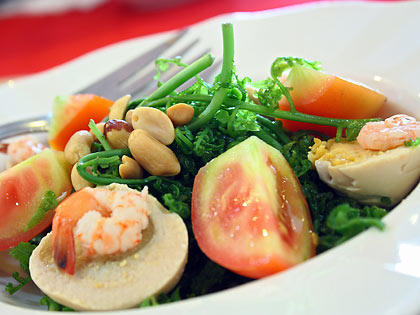
Paco or fiddlehead fern salad
Binulo Restaurant is relatively new but serves an excellent lineup of signature Kampangan dishes. First on our plates was the paco or fiddlehead fern salad served with tomatoes, onions, peanuts, salted duck eggs and shrimp in a light vinaigrette. We've tasted fern salad before – on a visit to a Mangyan settlement in Mindoro – but this was a pleasant surprise. The ferns were really crunchy and the vinaigrette dressing was excellent.
Some traditional Kapampangan dishes that are now favorites in many Filipino tables were next. Sisig is pork cheek and snout boiled until tender then grilled, chopped and mixed with liver, onions and chili peppers (see topmost photo). Kare-kare (another dish that originated from Pampanga but may also have been introduced by the pre-Hispanic Muslim settlers in Manila) is a peanut-flavored stew of oxtail, pork hocks, calves feet, pig feet, beef and sometimes tripe and offal with eggplants, Chinese cabbage and other vegetables thrown in. This kare-kare is one of the, if not the best, we've ever had.
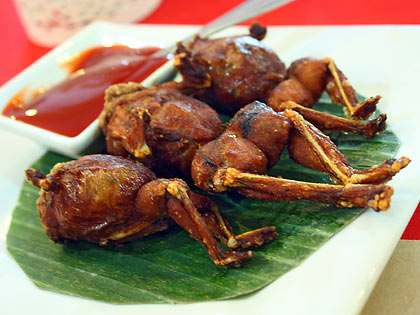
Batute or stuffed frogs
For the more adventurous palettes, Binulo serves batute or frogs with pork stuffing fried to crispy perfection. The stuffing is pretty good but I enjoyed the legs most of all. I've eaten frog legs on occasion – mostly in Chinese restaurants in Manila. It's like eating small chicken wings but since the bones are so crispy one can eat them as well. This batute was no exception. Nina and I were also looking around for kamaro or roasted mole crickets in garlic and onion but some friends in our group weren't yet prepared for that. (Not sure if the restaurant had that dish either.)
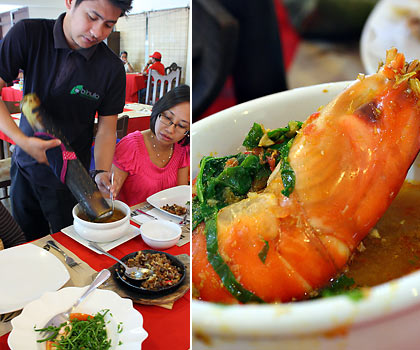
Pangat na ulang or giant shrimps/crayfish in a creamy, sour sauce; this dish is cooked inside a bamboo pole
Binulo is actually a term used for the native Aeta method of cooking food inside bamboo poles. The specialty at this restaurant, the pangat na ulang is cooked this way. These are giant freshwater shrimps (or is it crayfish?) in a creamy, sour sauce. The waiters will carry the poles to the table and empty the content of the pangat na ulang into your bowl. We also ordered rice cooked in this way. Wrapped inside a banana leaf, the rice almost looked like a traditional suman.
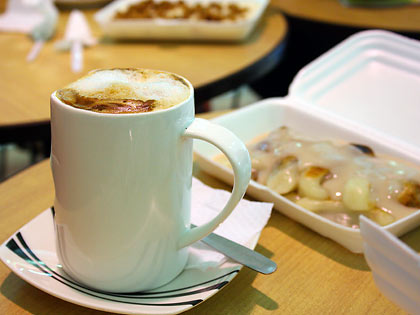
Time for coffee and sweets
After our hearty lunch it was time for coffee and dessert. We had wanted to drive over to Angeles City proper where many of the shops selling sweets are located but somehow ended up at the SM mall in Clark. We were gambling that some of the local shops would have their own branches here and we were correct. Susie's Cuisine has a stall at SM. We bought some of their specialties and brought them over to a local café named El Kapetan – with the storekeepers' permission.
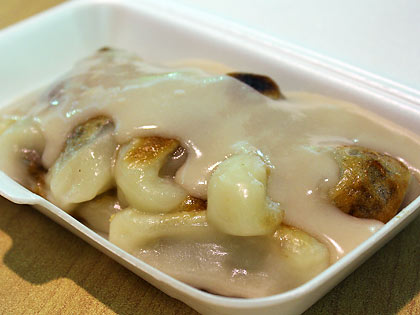
Akay-akay or glutinous rice balls with coconut cream sauce is originally from Bulacan but can be found throughout Pampanga.
Among those sweets was akay-akay or glutinous rice balls with munggo bean stuffing. A rich coconut cream sauce came with our order and we poured generous amounts on our akay-akay. We learned later that this sweet originated from Bulacan. Most Kapampangan desserts, however, are carabao milk-based rather than coconut-based and the rest of the sweets we got from Susie's reflected this.
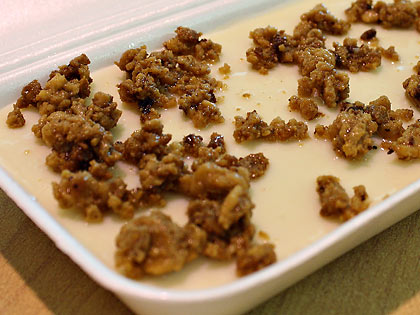
Tibok-tibok or carabao's milk pudding with latik topping
Tibok-tibok is Pampanga's panna cotta. It's a pudding made from carabao's milk and usually topped with latik or coconut curd fried until golden brown. Its silky and velvety texture makes it a favorite with us. (Manilenos know tibok-tibok more as maja blanca.)
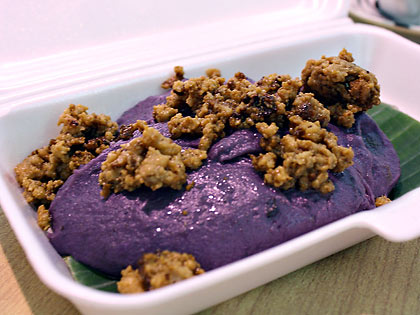
Halayang ube or purple yam fudge
Last on or list of desserts was the halayang ube or purple yam fudge, with its chewy and creamy texture. As with the tibok-tibok it was also topped with latik.
We probably should have stayed around for dinner and sampled other restaurants, but as with our other trips as of late, we had to get back to Metro Manila before it got dark. A more comprehensive Kapampangan food trip probably needs a few more days for us to really savor a wider range of Kapampangan dishes including the kamaro or roasted mole crickets, balo-balo or fermented rice used to accompany grilled catfish and burong talangka or fermented crablet fat. Not to mention visiting Aling Lucing's, home of the original sisig.
Still we arrived home feeling full and satisfied. This was a rare food trip where the whole group enjoyed every single dish (even the buko or coconut juice at Binulo and the coffee that we had at El Kapetan were both excellent). Here's looking forward to more food adventures in the culinary paradise that is Pampanga.


